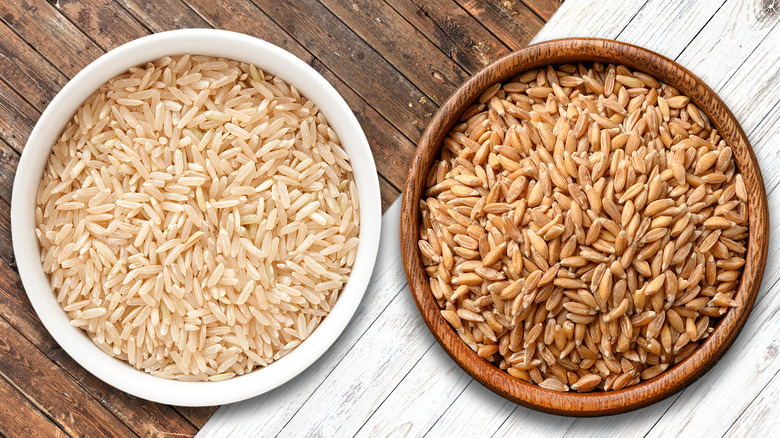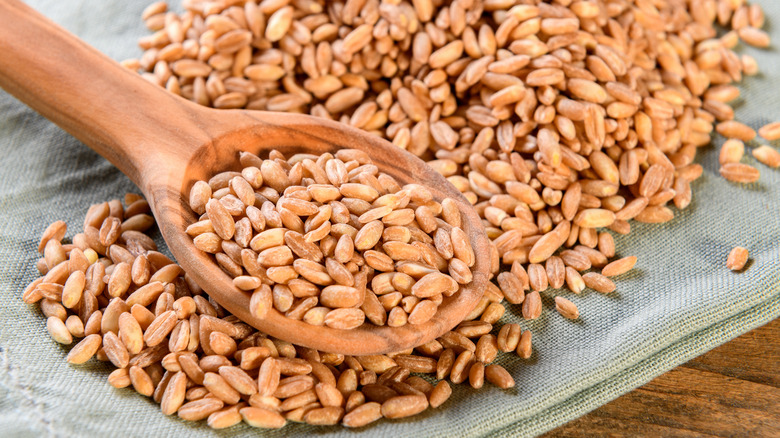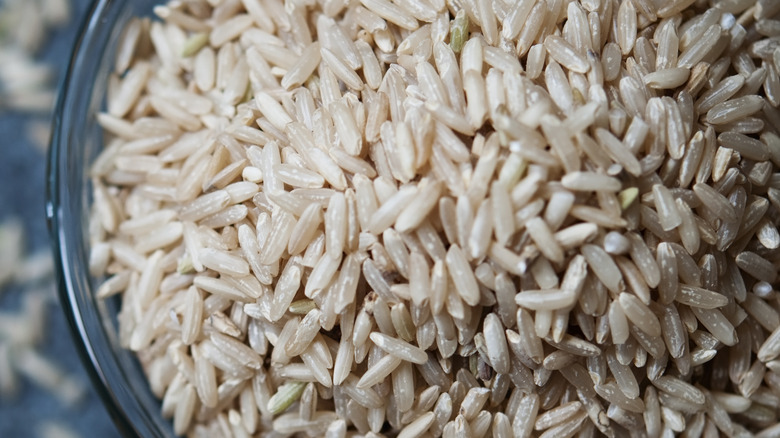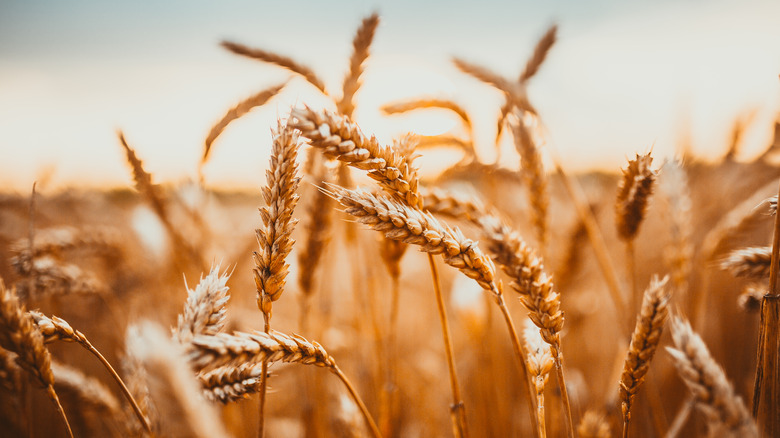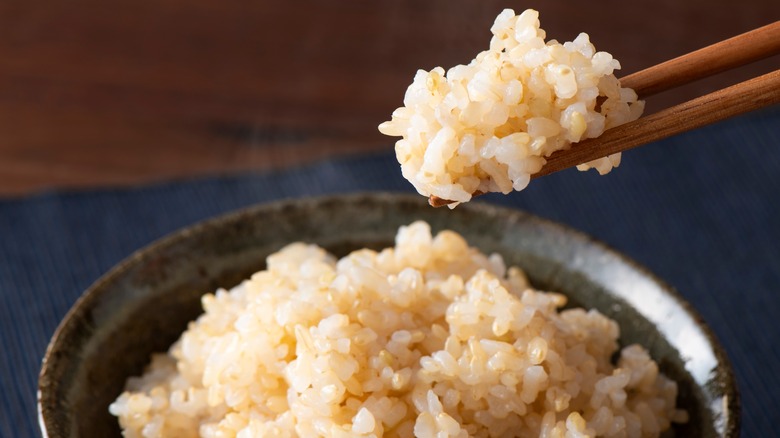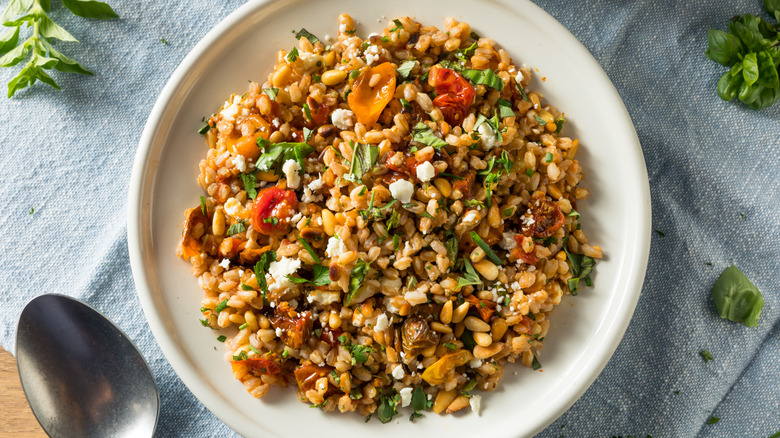Farro Vs. Brown Rice: What's The Difference?
With ingredients like wild rice, amaranth, and farro popping up on menus and in stores everywhere, it's hard to deny there are a lot of grains around these days. This is a great thing overall, as these grains are both flavorful and nutritious while bringing a satisfying diversity to meals and recipes. Yet with any proliferation of newly introduced foods, they are also bound to create some confusion. Amaranth may have a long history of feeding people in the Americas, but how many people today would know what they're getting when they order it? It also doesn't help that some of these grains look alike, and share similar flavors and cooking methods. This is especially true of farro and brown rice, two products with pretty different origins and histories that can be easy to confuse with each other once cooked.
While rice is its own cereal grain category, farro is a type of whole wheat. Both have a nutty flavor and similar texture when cooked, and both are healthier alternatives to their more processed cousins of white rice and white flour. But farro and brown rice have pretty different nutritional profiles when compared to each other. They also come from diverse regions of the world, China for rice and the Middle East and around the Mediterranean for farro, which influences how they are used.
What is farro?
Farro is a term for a whole grain that can come from any of three varieties of wheat – einkorn (Triticum monococcum), emmer (Triticum dicoccum), and spelt (Triticum spelta) – that have traditionally been grown around the Mediterranean and Middle East. Originating in Mesopotamia as long as 20,000 years ago, farro is considered an ancient grain, which means that it has been largely unchanged over time, and is not subject to the genetic mutation and cross-breeding of many modern wheats. It has been popular for centuries, eaten in ancient Egypt and Rome, and remains a key ingredient in Italian cooking, which has helped it gain recent popularity in the United States. Its flavor is toasty, reminiscent of nuts like cashews, with hints of warm spices, and its texture tends to be chewy when cooked.
There are three types of commercially sold farro: Whole, semi-pearled, and pearled. Whole farro retains the grain's entire bran, where most of the wheat's fiber is stored. Semi-pearled has part of the bran removed, and pearled has no bran at all. The more bran farro has, the more nutrients it will have, but it will also take longer to cook. Whole farro is so hard that it's recommended to soak it overnight before cooking. In the U.S., it's usually pearled farro that's available in stores although it's not always clearly labeled. It's cooked similarly to rice, by being boiled in water, usually at a water-to-farro ratio of 2:1.
What is brown rice?
Brown rice refers to any style of rice that retains all three parts of its seed: The bran, germ, and endosperm. White rice is simply rice that has had the bran and endosperm removed. It's the same difference between whole wheat flour versus white wheat. Most brown rice in the U.S. is standard long-grain, but any type of rice can be brown, like jasmine or arborio. As with other whole grains, brown rice has more fiber, protein, and nutrients than white. It has an earthy, nutty flavor, and because of its fiber and starch content, it tends to be chewier than white rice, and its starch content is more hidden so it's also less sticky. Because brown rice has such a distinct flavor, it can overpower many dishes where white rice is normally used, but it can also add earthy flavor and a more substantial texture to salads, grain bowls, and soups.
Importantly, its structure also means that brown rice cooks differently, taking longer to achieve a tender, fluffy texture. Brown rice can take between 20 and 40 minutes to fully cook, depending on the temperature and method used. Either way, it's far longer than white rice takes. You also need to use more water for brown rice, but going too far overboard can result in mush. Using 1 ¾ cups of water or stock to 1 cup of rice is a good starting point for brown rice.
Farro is a wheat product
Because of farro's shape and how it's eaten, it's easy to forget that it's a wheat product just like bread. Einkorn and emmer, two of the wheats that farro is made from, are the oldest cultivated styles of wheat in the world, originating in what's now Turkey. Different cultivars of wheat have surpassed the originals in popularity, but farro's enduring appeal has helped einkorn and emmer survive. Since farro is wheat it does have gluten in it, but because of its ancient grain heritage it will have less gluten than other forms of wheat. In this way it's often thought of as similar to barley, another relative of wheat that contains some gluten and is eaten as a whole grain.
Like wheat, rice is a type of grass, but it's a different species with different origins. Rice was first cultivated in China more than 7,000 years ago, far from wheat's home in the Middle East. Unlike wheat, rice is a semi-aquatic grass, which is why it is more cultivated in tropical and subtropical regions. Brown rice, like any rice, does not contain any gluten, and its nutritional profile can be significantly different from wheat products like farro.
Brown rice has fewer calories than farro, but also less protein and fiber
Comparing the nutritional profile of grains can be tricky because of serving size differences, but overall farro is a bit more nutrient-dense than brown rice. One cup of brown rice is the rough caloric equivalent of only half to a third of a cup of farro, but one tends to eat a bit less farro than brown rice per portion. Both are also similarly high in carbohydrates. If eating the same caloric equivalent, farro will have around 50% more protein and fiber than rice. This nutritional information is for pearled farro specifically, so fully whole-grain versions will have even more protein and fiber.
However, brown rice is still rich in nutrients and has higher levels of some vitamins and minerals than farro does. Brown rice has a greater level and variety of B vitamins like niacin. It is also extremely high in copper and manganese. While farro is more weighty in terms of nutrients than brown rice, it doesn't have quite the variety of minerals. Farro does have brown rice beat in iron and calcium.
Whatever the difference between farro and brown rice, it's important to remember that as whole grains both are great nutritional options, and both deliver more nutritional benefits than their white, processed cousins.
Farro is a staple of Mediterranean cooking
From its origins in China, rice has become a staple all over the world, but farro remains more tied to the flavors of its birthplace. It can find a home in many Mediterranean dishes, but it's most associated with Italy. Filling, nutty farro is used in Italian soups, where it can add whole-wheat goodness to a sausage and kale soup, or transform tomato soup into more of a full meal. It can also be served cold as part of a salad. It's especially tasty with a caprese, where it brings hearty flavors to an otherwise fresh, light dish. Farro is probably most popular as a basis for Mediterranean-inspired grain bowls. Top it with sauteed mushrooms and greens, or toss it with dressing, olives, feta, and crunchy fresh veggies.
Brown rice is much more of an all-purpose workhorse. It can be used in a lot of the same soups or bowls that farro can, but it can also be subbed in for white rice in a lot of recipes. If a dish is saucy enough that the grain is more of a filler, like a curry, that's a great spot for brown rice, where you can get more nutrition without altering the flavor of the meal much. You shouldn't shy away from brown rice's flavor, as it can be a delicious base for a meal too, you just need to be ready for it to assert itself more than white rice.
